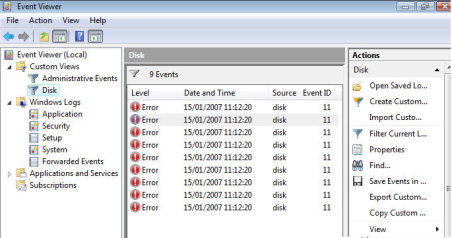Windows Vista Event – Viewer Improvements
I urge you to give the Vista Event Viewer a chance to impress. Make a resolution to visit the interface at least once a week. Then should disaster strike, your experience will give you a baseline of what a healthy machine looks like. Moreover, any exceptions will stand out and you will know how to drill down and find the crucial troubleshooting information.
Windows Vista – Event Viewer Topics
- Reasons to Master the Event Viewer
- Launching the Vista Event Viewer
- New Event Logs in Vista
- SolarWinds Event Manager
- Get Into Good Habits
- Windows 8 Event Viewer
Reasons to Master the Vista Event Viewer
Microsoft has improved the Event Viewer, as a result in Vista there is now a console with three resizable window panes. The benefit of the new design makes it is easier to:
- To solve a specific Vista problem
- To discover why a machine is performing slowly
- To prevent nuisances developing into disasters
♦
Launching the Vista Event Viewer
To get started, click on the Vista Start button, then in the ‘Start Search’ box type just three letters: eve. Observe how the larger dialog box displays: ‘Programs’ and underneath: ‘Event Viewer’. Click on ‘Event Viewer’.

Alternatively, you could type the full word ‘event viewer in the Start Search dialog box and then press enter. In Vista there are still two or even three ways of performing most tasks.
As with so many Vista features, Microsoft has improved the Event Viewer compared with its XP predecessor. What particularly impressed me was the slick organization of the vast amount of troubleshooting data. Everywhere you look, from the 3 pane layout, to the categories in Applications and Services Logs, it’s obvious that Microsoft has invested considerable effort in researching what people want and then delivering the information to troubleshoot specific Vista events.
New Event Logs in Vista
Vista has added two new logs to the Event Viewer: Setup and Forwarded Events. To find these menu items, look in the left hand pane underneath ‘Windows logs’, in amongst the familiar: Application, Security and System logs are the two new logs, Setup and Forwarded Events.
When you add new programs, the Setup log records events relating to the installation of each new application. The Forward Events log contains event ids from other computers. You can specify which events to collect via the Event Subscription menu (see above screen shot at the bottom of the menu in the left pane)
Application and Service Logs
®

